|


by
Dr Valery Uvarov
Department N13 - National
Security Academy - St Petersburg - Russia
Extracted from
Nexus Magazine, Volume 11, Number 1
December 2003-January 2004
|
Across a vast area of
sparsely populated Yakutia in Siberia can be found
strange metallic structures and evidence of devastating
nuclear-type explosions every six or seven centuries.
|
In northwestern Yakutia in
Siberia, in the basin of the Upper Viliuy River,
there is a hard-to-reach area that bears the marks of a tremendous
cataclysm that took place some 800 years ago, which toppled the
entire forest cover and scattered stone fragments over hundreds of
square kilometers. Distributed across this area are mysterious metal
objects located deep underground in the permafrost. On the surface,
their presence is revealed only by patches of weird vegetation. The
ancient name of this area is Uliuiu Cherkechekh, which
translates as "the Valley of Death".
For many years the Yakut people have given a very wide berth
to this remote area that has played and still plays a special,
powerful role in the fate not only of civilization but of the planet
as a whole.
After having systematized a large quantity of reports and material
of various kinds, we decided to inform you of something that may
change perceptions of the world around us and our place in it, if
humanity can take heed of what is stated here.
In order to provide the fullest possible picture, we have divided
our account into three sections. The first contains
the facts and eyewitness reports in the form in which they reached
us. The second presents the ancient legends of peoples living
in this region and the epic poetry of neighboring peoples who
observed strange phenomena. This is important so that you can carry
out your own investigation and appreciate for yourselves every
detail of the narrative. Finally, we discuss what lies behind
all this [see Part 2].
Eyewitness Reports
The area in question can be described as a solid mass of swamps,
alternating with near-impassable taiga, covering more than 100,000
square kilometers. Some fairly curious rumors have become attached
to the area regarding metal objects of unknown origin located
across its expanse.
In order to shed light on whatever it was that, existing barely
perceptibly alongside us, gave rise to these rumors, we had to go
into the ancient history of this region to discover its beliefs and
legends. We managed to recreate certain elements of the local
palaeotoponymy and these matched in an astonishing manner the
content of the ancient legends. Everything indicated that the
legends and rumors were referring to quite specific things.
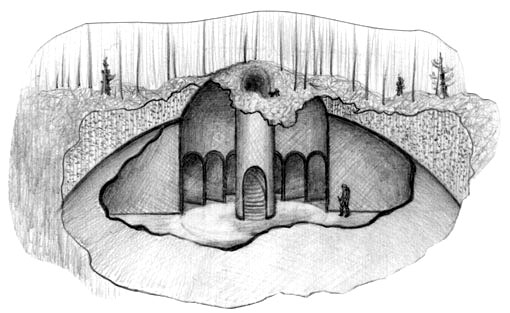
In ancient times, the Valley of
Death was part of a nomadic route used by the Evenk
people, from Bodaibo to Annybar and
on to the coast of the Laptev Sea. Right up until
1936, a merchant named Savvinov traded on the route; when he
gave up the business, the inhabitants gradually abandoned those
places. Finally, the aged merchant and his granddaughter Zina
decided to move to Siuldiukar. Somewhere in the land
between two rivers that is known as Kheldyu ("iron house"
in the local language), the old man led her to a small, slightly
flattened reddish arch where, beyond a spiral passageway, there
turned out to be a number of metal chambers in which they
then spent the night. Zina’s grandfather told her that even
in the harshest frosts it was warm as summer in the chambers.
In days gone by, there were bold men among the local hunters who
would sleep in these rooms. But then they began to fall seriously
ill, and those who had spent several nights in a row there soon
died. The Yakut said that the place was "very
bad, marshy, and beasts do not go there". The location of all these
constructions was known only to old men who had been hunters in
their youth and had often visited these places. They lived a nomadic
life and their knowledge of the peculiarities of the area—where one
could go, and where one couldn’t—was a matter of vital necessity.
Their descendants have adopted a settled way of life, so this
knowledge from the past has been lost.
At present, the only things that point to the existence of these
constructions are ancient place names that have survived in part and
all manner of rumors. But each of those toponyms represents
hundreds, if not thousands, of square kilometres.
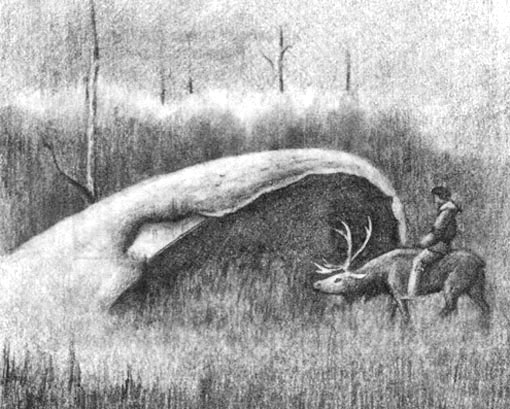
In 1936, alongside the Olguidakh
("place with a cauldron") River, a geologist
directed by elderly natives came upon a smooth metal hemisphere,
reddish in colour, protruding from the ground with such a sharp edge
that it "cut a fingernail". Its walls were about two centimeters
thick and it stuck out of the ground roughly a fifth of its
diameter. It stood leaning over so that it was possible to ride
under it on a reindeer. The geologist dispatched a description of it
to Yakutsk, the regional centre. In 1979, an
archaeological expedition from Yakutsk attempted to find the
hemisphere he had discovered. The team members had with them a guide
who had seen the structure several times in his youth, but he
said that the area was greatly changed and so they failed to find
anything. It must be said that in that locality you can pass within
10 paces of something and not notice it, so earlier discoveries have
been pure luck.
Back in 1853, R. Maak, a noted explorer of the region, wrote:
"In Suntar [a Yakut
settlement] I was told that in the upper reaches of the
Viliuy there is a stream called Algy timirbit
(which translates as "the large cauldron sank") flowing
into the Viliuy. Close to its bank in the forest there is
a gigantic cauldron made of copper. Its size is unknown as only
the rim is visible above the ground, but several trees grow
within it…"
The same thing was recorded by N. D.
Arkhipov, a researcher into the ancient cultures of Yakutia:
"Among the population of the
Viliuy basin there is a legend from
ancient times about the existence in the upper reaches of that
river of bronze cauldrons or olguis. This legend
deserves attention as the areas that are the supposed location
of the mythical cauldrons contain several streams with the name
Olguidakh— ’Cauldron Stream’."
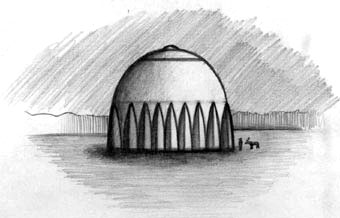
And here is a passage from a letter
penned in 1996 by another person who visited the Valley of Death.
Mikhail Koretsky from Vladivostok wrote:
"I was there three times. The first
time was in 1933, when I was ten—I travelled with my father when
he went there to earn some money—then in 1937, without my
father. And the last time was in 1947 as part of a group of
youngsters.
"The ’Valley of Death’ extends along a right-hand
tributary of the Viliuy River. In point of fact it
is a whole chain of valleys along its flood lands. All three
times I was there with a guide, a Yakut. We didn’t go
there because life was good, but because there, in the back of
beyond, you could pan for gold without the threat that at the
end of the season you’d be robbed or get a bullet in the back of
your head.
"As for mysterious objects, there are probably a lot of them
there, as in three seasons I saw seven of those ’cauldrons’.
They all struck me as totally perplexing: for one thing, there
was their size—between six and nine meters in diameter.
"Secondly, they were made of some strange metal. Everyone
has written that they were made of copper, but I’m sure it isn’t
copper. The thing is that even a sharpened cold chisel will not
mark the ’cauldrons’ (we tried more than once). The metal
doesn’t break off and can’t be hammered. On copper, a hammer
would definitely have left noticeable dents. But this ’copper’
is covered over with a layer of some unknown material resembling
emery. Yet it’s not an oxidation layer and not scale—it can’t be
chipped or scratched, either.
"We didn’t come across shafts going down into the ground with
chambers. But I did note that the vegetation around the
’cauldrons’ is anomalous—totally different from what’s
growing around. It’s more opulent: large-leaved burdock; very
long withes; strange grass, one and a half or two times the
height of a man. In one of the ’cauldrons’, the
whole group of us (six people) spent the night. We didn’t sense
anything bad, and we calmly left without any sort of unpleasant
occurrences. Nobody fell seriously ill afterwards. Except that
three months later, one of my friends lost all his hair. And on
the left side of my head (the side I slept on), three small sore
spots the size of match-heads appeared. I’ve tried to get rid of
them all my life, but they’re still with me today.
"None of our efforts to break off even a small piece from the
strange ’cauldrons’ was successful. The only thing I did
manage to bring away was a stone. Not an ordinary one, though:
half of a perfect sphere, six centimeters in diameter. It was
black in colour and bore no visible signs of having been worked,
yet was very smooth as if polished. I picked it up from the
ground inside one of those cauldrons.
"I took my souvenir of Yakutia with me to the
village of Samarka, Chuguyevka
district, Primorsky region (the Soviet Far East), where my
parents were living in 1933. I was laid up with nothing to do
until my grandmother decided to build a house. We needed to put
glass in the windows and there wasn’t a glass-cutter in the
entire village. I tried scoring it with the edge of that half of
a stone sphere, and it turned out to cut with amazing ease.
After that, my find was often used like a diamond by all our
relatives and friends. In 1937 I gave the stone to my
grandfather, but that autumn he was arrested and taken to
Magadan where he lived on without trial until 1968 and then
died. Now no-one knows where my stone got to…"
In his letter, Koretsky stresses
that in 1933 his Yakut guide told him that:
"…five or ten years before, he had
discovered several spherical cauldrons (they were
absolutely round) that protruded high (higher than a man) out of
the ground. They looked brand new. Later the hunter had seen
them again, now broken and scattered."
Koretsky also noted that when he
visited one "cauldron" a second time, in the intervening few
years it had sunk appreciably into the ground.
A. Gutenev and Yu. Mikhailovsky, two researchers who
lived in the town of Mirny in Yakutia,
reported that in 1971 an old hunter belonging to the Evenk people
had said that in the area between two rivers known as
Niugun Bootur ("fiery champion") and Atadarak ("place
with a three-sided harpoon"), there is poking out of the ground the
very thing that gave the place its name—a "very big" three-faceted
iron harpoon—while in the area between two rivers known as
Kheliugur ("iron people"), there is an iron
burrow in which lie "thin, black, one-eyed people in clothes of
iron". He said that he could take people there, that it was not
far away, but no-one believed him. In the meantime, he died.
One more of these objects was, to all appearances, covered after the
building of a dam on the Viliuy, slightly below the Erbiie.
According to the account of one of the builders of the Viliuy
hydro-electric project, when they constructed a diversion canal
and drained the main channel they discovered in it a convex metal
"spot". Deadlines were pressing and after a cursory inspection of
the find the project managers gave orders for work to continue.
There is a host of tales from people who came across similar
constructions by accident, but without precise directions it is
extremely difficult to find these again in the depressingly
monotonous terrain.
Once some old men said that flowing in the place called Tong
Duurai is a stream called Ottoamokh ("holes
in the ground") and that around it there are incredibly deep
openings known as "the laughing chasms". That same name also
crops up in legends that state that this is the dwelling of a
fiery giant who destroys everything around. Roughly every six or
seven centuries, a monstrous "fireball" bursts out
from there and it either flies off somewhere into the distance and
(judging by the chronicles and legends of other peoples) explodes
there, or it explodes directly above its exit point—as a result of
which, the area for hundreds of kilometers around has been reduced
to a scorched desert with shattered rocks.
Yakut legends contain many references to explosions, fiery
whirlwinds and blazing spheres rising into the air. And all those
phenomena are somehow or other associated with the mysterious metal
constructions found in the Valley of Death. Some of
them are large, round, "iron houses" standing on numerous
lateral supports. They have neither windows nor doors, only a
"spacious manhole" at the top of the dome.
Some of them have sunk almost completely
into the permafrost, with only a barely noticeable arch-like
protuberance remaining on the surface. Witnesses who are strangers
to each other describe this "resounding metal house" in the
same way. Other objects scattered across the area are the metallic
hemispherical lids that cover something unknown. Yakut legends
say that the mysterious blazing spheres are produced by "an orifice
belching smoke and fire" with a "banging steel lid".
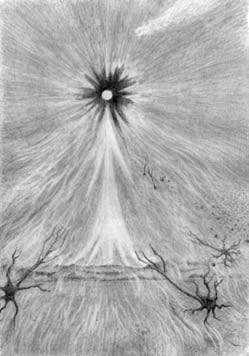
This is also the source for the fiery
whirlwinds that from the descriptions sound very similar to the
effects of present-day atomic explosions. Roughly a century
before each explosion or series of explosions, a fast-flying
fiery sphere emerged from the "iron orifice" and, without
causing great damage, soared upwards in the form of a thin column of
fire. At the top of this, a very large fireball appeared.
Accompanied by four claps of thunder in succession, it soared to an
even greater height and flew off, leaving behind a long "trail of
smoke and fire". Then a cannonade of its explosions sounded in the
distance...
In the 1950s, the Soviet military cast an eye over this area,
evidently due to the exceptionally sparse population on its northern
fringes, and conducted a series of atomic tests there. One of the
explosions produced a great puzzle, and foreign specialists are
still speculating about it. As the German radio station Deutsche
Welle reported in September 1991 that, when a 10-kilogram
nuclear device was being tested in 1954, for unknown reasons the
size of the explosion exceeded the calculations by a factor of 2,000
to 3,000, reaching 20–30 megatons, as was registered by seismic
laboratories around the world. The cause of such a significant
discrepancy in the power of the explosion remained unclear. The
news agency TASS put out an announcement that a
compact hydrogen bomb had been tested in airburst conditions, but it
later emerged that this was incorrect. After the tests, restricted
zones were established in the area and secret work was carried out
for some years.
Myths and Legends
 Let
us try to look into the distant past as it is reflected in epic
poetry. As the legends passed on by word of mouth testify, in the
remote period when everything began, the area was inhabited by a
small number of Tungus nomads. Once upon a time, their
distant neighbours saw that their land was suddenly wrapped in
impenetrable darkness and the surroundings were shaken by a
deafening roar. A hurricane of unseen force arose and the land was
riven by mighty blows. Lightning crossed the sky in all directions.
When everything calmed down and the darkness dispersed, an
unprecedented sight met the nomads’ eyes. In the midst of the
scorched land, glowing in the sun stood a tall vertical structure
that was visible at a distance of many days’ journey. Let
us try to look into the distant past as it is reflected in epic
poetry. As the legends passed on by word of mouth testify, in the
remote period when everything began, the area was inhabited by a
small number of Tungus nomads. Once upon a time, their
distant neighbours saw that their land was suddenly wrapped in
impenetrable darkness and the surroundings were shaken by a
deafening roar. A hurricane of unseen force arose and the land was
riven by mighty blows. Lightning crossed the sky in all directions.
When everything calmed down and the darkness dispersed, an
unprecedented sight met the nomads’ eyes. In the midst of the
scorched land, glowing in the sun stood a tall vertical structure
that was visible at a distance of many days’ journey.
For a long time, the structure gave out unpleasant, ear-splitting
noises and gradually diminished in height until it disappeared under
the ground altogether. In place of the tall structure there was an
immense, yawning, vertical "orifice". In the strange words of the
legends, it consisted of three tiers of "laughing chasms".
Its depths supposedly contained an underground country with its own
sun that was, however, "waning". A choking stench rose from
the orifice, and so no-one settled near it. From a distance, people
could sometimes see a "rotating island" appear above the opening,
and this then proved to be its "banging lid". Those who were tempted
by curiosity to take a closer look never returned.
Centuries went by. Life went on as before. Nobody anticipated
anything extraordinary, but one day a small earthquake occurred and
the sky was pierced by a thin "fiery whirlwind". At
the top of it, a dazzling fireball appeared. Accompanied by
"a succession of four thunderclaps" and leaving behind a trail of
fire, this sphere shot off along a shallow downward trajectory and,
after vanishing beyond the horizon, exploded. The nomads were
perturbed but did not abandon the lands that were home to them,
since the "demon" had not caused them any harm but had
exploded over the lands of the hostile neighbouring tribe. A few
decades later, events repeated themselves: the fireball flew off
in the same direction and again destroyed only their neighbours.
Evidently this "demon" was in some way their protector
and they began to create legends about it, calling it Niurgun
Bootur, "the fiery champion".
But some time later, events occurred that horrified those in even
the most distant surroundings. A gigantic fireball emerged
from the opening with a deafening, thunderous roar and
exploded—right overhead! A tremendous earthquake ensued. Some
hills were cut across by a crack more than 100 meters deep.
Following the explosion, a "fire-raging sea" continued to swash
about with a disc-like "rotating island" above it. The
effects of the explosion extended over a radius of more than a
thousand kilometers. The nomadic tribes which survived on the edges
of the area fled in different directions, seeking to distance
themselves from the fatal spot, but that did save them from death.
They all succumbed to some kind of strange illness that was
passed on only by inheritance. Yet they left behind them
precise accounts of what had taken place, on the basis of
which Yakut storytellers began to compose beautiful,
exceptionally tragic legends.
A little over 600 years passed. Many generations of nomads
had come and gone. The precepts of the remote ancestors had been
forgotten and people again settled the area.
Then history repeated itself… The fireball of Niurgun Bootur
appeared above a fiery whirlwind and again flew off to explode
beyond the horizon. A few decades later, a second fireball rent
the air (now it was called Kiun Erbiie - "the gleaming
aerial herald" or "messenger"). Then came another
devastating explosion that the legends again anthropomorphized. It
was given the name Uot Usumu Tong Duurai, which can be
roughly translated as "the criminal stranger who pierced the
earth and hid in the depths, destroying all around with a fiery
whirlwind".
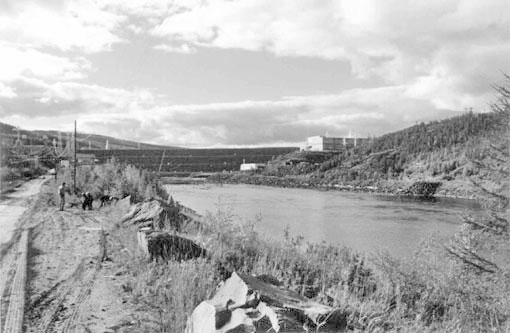
It is important to note that on the eve
of the flight of the negative hero Tong Duurai, there
appeared in the sky the messenger of the heavenly Dyesegei—the
champion Kiun Erbiie who crossed the firmament as a "falling
star" or "dashing lightning" so as to warn Niurgun Bootur
of the coming battle.
The most significant event in the legends was Tong Duurai
bursting forth from the underground depths and doing battle with
Niurgun Bootur. This took place roughly as follows:
firstly, a snake-like,
branching, fiery whirlwind burst forth from the "orifice",
on the top of which there again appeared a fireball of
gigantic size which, after several peals of thunder, shot
high into the air. He was accompanied in flight by his
retinue—"a swarm of fatally bloody whirlwinds" that wrought
havoc in the vicinity.
But there were occasions when Tong
Duurai encountered Niurgun Bootur above the
place where he took off; and following these, the area remained
lifeless for a long time. The picture painted of these events varies
quite considerably: several "fiery champions" might emerge from the
opening at once, fly some distance and explode in one place. This
happened with the flight of Tong Duurai. A study of the soil layers
indicates that the interval between explosions does not exceed
600–700 years.
The legends vividly reflect these events, but the absence of a
written tradition means that they have not been registered in
documentary form. It seems, though, that this lacuna is compensated
for by the historical chronicles of other peoples.
The Chronicles of Other Peoples
Altogether, at approximate intervals of 600–700 years, several
explosions or, rather, a whole complex of events including the
precursors, took place. All these occurrences were painstakingly
recorded in epic poetry, traditions and legends. It is a curious
fact that similar legends arose in the equatorial zone of the
planet, where explosions or "giant fireballs" that
suddenly appeared in the sky destroyed several centers of ancient
civilizations.
Judging by the results of archaeological investigations carried out
in the Upper Viliuy region by S. A. Fedoseyeva, the
intermittent, wave-like settlement of this territory can be traced
back roughly to the fourth millennium BC. In the first
millennium AD, the line of historical development is interrupted—and
this does not contradict the possible date for the last
historical explosion as September 1380. The cloud it raised
blotted out the Sun over Europe for several hours. In several
geo-active zones, powerful earthquakes took place.
This event is recorded in written sources. In Russian chronicles, it
coincided with the Battle of Kulikovo Field:
"…the gloom dispersed only in the
second half of the day. A wind of such strength blew, that an
arrow shot from a bow could not fly against it…"
This factor made a positive contribution
to the Russian victory.
However, the explosions are described in Tungus legends
far more vividly than in other sources. Judging by the accounts,
they were many times worse than modern nuclear weapons.
If we take 1380 as our starting date and go back into the past, we
can trace such moments. In 830, for example, the culture of the
Mayans who inhabited the Yucatán Peninsula in Mexico
was destroyed. Many of their cities were reduced to ruins by
an explosion of monstrous force.
Some passages in the Bible are akin to the Yakut legends,
e.g., the description of the plagues of Egypt and the demise of
Sodom and Gomorrah. In one of the oases of the Arabian
Peninsula, an ancient town was destroyed and literally reduced to
ashes. According to legend, this took place when a huge
fireball that appeared in the sky exploded.
At
Mohenjo-daro on the Indian
subcontinent, archaeologists discovered a devastated city. The marks
of the catastrophe—melted stone walls—clearly pointed to an
explosion comparable with a nuclear bomb. Similar events are also
described in Chinese chronicles from the 14th century.
They say that, far to the north, a black cloud rose above the
horizon and covered half the sky, scattering large fragments of
stone. Stones also dropped from the sky in Scandinavia and Germany,
where fire broke out in several towns. Scholars established that
they were quite ordinary stones, and conjectured that a volcano had
erupted somewhere.
Perhaps the cause of these misfortunes was really Tong Duurai
who has been bursting out from under the ground for many centuries?
While Niurgun Bootur blotted out half of the sky at
his appearance, Tong Duurai considerably exceeded him
in size and, ascending into the heavens, completely disappeared from
view.
We note that in the Valley of Death, a rise in the
background radiation is observed at certain intervals of time—a
phenomenon that specialists can’t explain.
|





 Let
us try to look into the distant past as it is reflected in epic
poetry. As the legends passed on by word of mouth testify, in the
remote period when everything began, the area was inhabited by a
small number of Tungus nomads. Once upon a time, their
distant neighbours saw that their land was suddenly wrapped in
impenetrable darkness and the surroundings were shaken by a
deafening roar. A hurricane of unseen force arose and the land was
riven by mighty blows. Lightning crossed the sky in all directions.
When everything calmed down and the darkness dispersed, an
unprecedented sight met the nomads’ eyes. In the midst of the
scorched land, glowing in the sun stood a tall vertical structure
that was visible at a distance of many days’ journey.
Let
us try to look into the distant past as it is reflected in epic
poetry. As the legends passed on by word of mouth testify, in the
remote period when everything began, the area was inhabited by a
small number of Tungus nomads. Once upon a time, their
distant neighbours saw that their land was suddenly wrapped in
impenetrable darkness and the surroundings were shaken by a
deafening roar. A hurricane of unseen force arose and the land was
riven by mighty blows. Lightning crossed the sky in all directions.
When everything calmed down and the darkness dispersed, an
unprecedented sight met the nomads’ eyes. In the midst of the
scorched land, glowing in the sun stood a tall vertical structure
that was visible at a distance of many days’ journey.